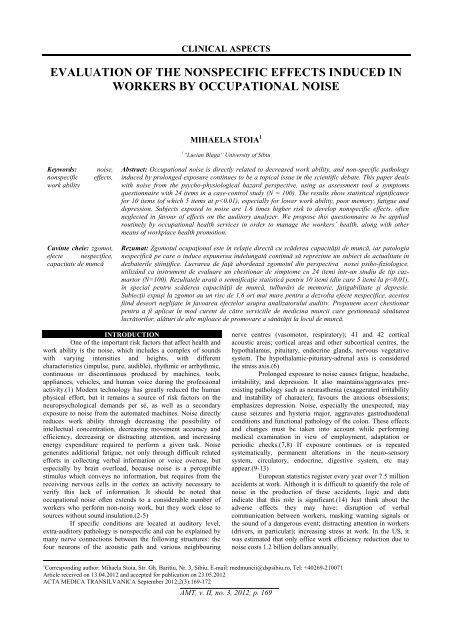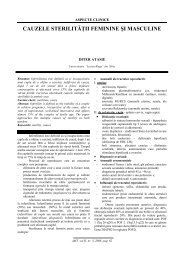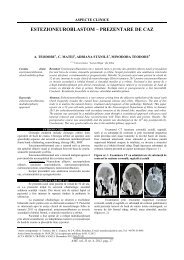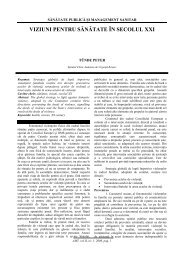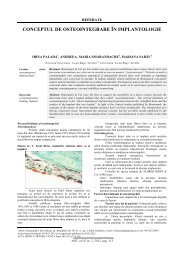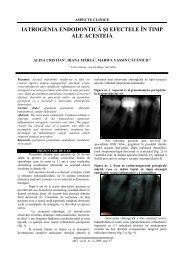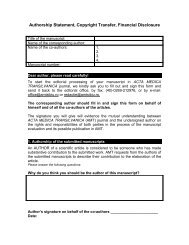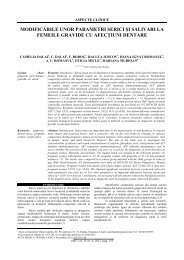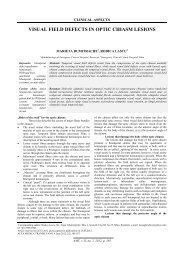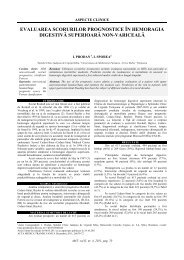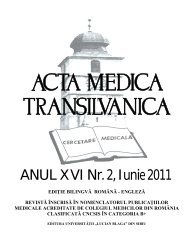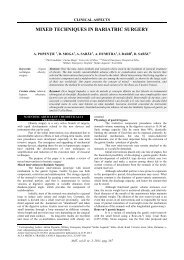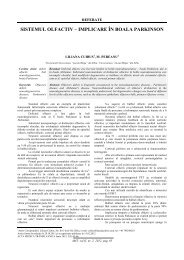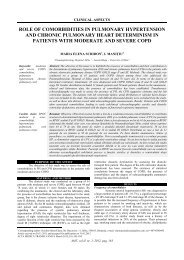full text article in English - Acta Medica Transilvanica
full text article in English - Acta Medica Transilvanica
full text article in English - Acta Medica Transilvanica
Create successful ePaper yourself
Turn your PDF publications into a flip-book with our unique Google optimized e-Paper software.
CLINICAL ASPECTS<br />
EVALUATION OF THE NONSPECIFIC EFFECTS INDUCED IN<br />
WORKERS BY OCCUPATIONAL NOISE<br />
MIHAELA STOIA 1<br />
1 “Lucian Blaga” University of Sibiu<br />
Keywords:<br />
nonspecific<br />
work ability<br />
noise,<br />
effects,<br />
Abstract: Occupational noise is directly related to decreased work ability, and non-specific pathology<br />
<strong>in</strong>duced by prolonged exposure cont<strong>in</strong>ues to be a topical issue <strong>in</strong> the scientific debate. This paper deals<br />
with noise from the psycho-physiological hazard perspective, us<strong>in</strong>g as assessment tool a symptoms<br />
questionnaire with 24 items <strong>in</strong> a case-control study (N = 100). The results show statistical significance<br />
for 10 items (of which 5 items at p
CLINICAL ASPECTS<br />
PURPOSE<br />
The study aims at evaluat<strong>in</strong>g the direct or derivative<br />
effects of occupational exposure to noise.<br />
METHODS<br />
Study Material:<br />
We have selected two groups (a total of 100 subjects),<br />
as follows:<br />
- Group of cases (c): 50 subjects exposed to noise <strong>in</strong> a wood<br />
process<strong>in</strong>g enterprise (furniture), with primary process<strong>in</strong>g,<br />
and mechanized sections;<br />
- The control group (m): 50 subjects from the section<br />
“F<strong>in</strong>ish<strong>in</strong>g-Packag<strong>in</strong>g” of the same company, without noise<br />
exposure (table no. 1)<br />
Table no. 1. Ma<strong>in</strong> characteristics of the studied groups<br />
Mean<br />
Group<br />
length of<br />
Mean age<br />
service <strong>in</strong><br />
(years)<br />
the same<br />
job (years)<br />
Gender<br />
Cases<br />
(50)<br />
Controls<br />
(50)<br />
37.52±8.51 15.34±6.11<br />
35.29±6.81 12.43±7.75<br />
10<br />
females<br />
(20%)<br />
40 males<br />
(80%)<br />
15<br />
females<br />
(30%)<br />
35 males<br />
(70%)<br />
Profession /<br />
occupation<br />
25<br />
carpenters<br />
15<br />
processors<br />
10 unskilled<br />
31 packers<br />
19 unskilled<br />
Note: “±” signifies standard deviation<br />
Occupational noise assessment<br />
Noise <strong>in</strong>tensity was measured with the digital sound<br />
level meter with <strong>in</strong>tegrated sound system type Quest 2800,<br />
appropriate to the quality standards of the European Union. The<br />
pr<strong>in</strong>ciple of the method is to turn the device’s microphone<br />
captured sounds <strong>in</strong>to electrical signals and display them on<br />
screen, directly <strong>in</strong> decibels, <strong>in</strong> the weight<strong>in</strong>g circuit A.<br />
Questionnaire of symptoms (for nonspecific effects of noise)<br />
We used a questionnaire of symptoms (subjective<br />
compla<strong>in</strong>ts) consisted of 24 items, of which specific effects of<br />
noise (2 items), and especially non-specific effects such as<br />
fatigue, anxiety, attention, memory impairment, palpitations,<br />
irritability, sleep disorders etc. grouped <strong>in</strong>to short-term effects (6<br />
items), and long term effects (16 items).<br />
Creat<strong>in</strong>g a database and statistical analysis<br />
We used data from the follow<strong>in</strong>g sources: medical<br />
records (pathological outcomes PO), psychological<br />
exam<strong>in</strong>ations, electrocardiogram (ECG), and cl<strong>in</strong>ical<br />
exam<strong>in</strong>ation with measur<strong>in</strong>g blood pressure (BP). Statistical<br />
analysis was performed us<strong>in</strong>g Microsoft Office Excel 2003 and<br />
Chi-Square Test (p
CLINICAL ASPECTS<br />
Table no. 2. Integrated quantitative analysis of survey results<br />
Group<br />
PO<br />
Frequency ECG<br />
of<br />
responses normal modified<br />
Measured BP values<br />
Psychological<br />
(mmHg)<br />
exam (low<br />
attention) normal <strong>in</strong>creased<br />
Hypertension<br />
Duodenal<br />
ulcer<br />
Cases 16 4 228 34 16 4 30 20<br />
Controls 8 0 141 41 9 0 45 5<br />
Table no. 3. Statistically significant results of the questionnaire by Chi-Square Test<br />
group<br />
Variable<br />
c m Total<br />
Pallor<br />
Visual<br />
disorders<br />
Depression<br />
Memory<br />
disorders<br />
Hypertension<br />
Decrease <strong>in</strong><br />
work ability<br />
Tachycardia<br />
1 Count 3 0 3<br />
% of Total 3.9% .0% 3.9%<br />
2 Count 35 38 73<br />
% of Total 46.1% 50.0% 96.1%<br />
Total Count 38 38 76<br />
% of Total 50.0% 50.0% 100.0%<br />
1 Count 2 10 12<br />
% of Total 2.6% 13.2% 15.8%<br />
2 Count 36 28 64<br />
% of Total 47.4% 36.8% 84.2%<br />
Total Count 38 38 76<br />
% of Total 50.0% 50.0% 100.0%<br />
1 Count 7 0 7<br />
% of Total 9.2% .0% 9.2%<br />
2 Count 31 38 69<br />
% of Total 40.8% 50.0% 90.8%<br />
Total Count 38 38 76<br />
% of Total 50.0% 50.0% 100.0%<br />
1 Count 30 15 45<br />
% of Total 39.5% 19.7% 59.2%<br />
2 Count 8 23 31<br />
% of Total 10.5% 30.3% 40.8%<br />
Total Count 38 38 76<br />
% of Total 50.0% 50.0% 100.0%<br />
1 Count 17 8 25<br />
% of Total 22.4% 10.5% 32.9%<br />
2 Count 21 30 51<br />
% of Total 27.6% 39.5% 67.1%<br />
Total Count 38 38 76<br />
% of Total 50.0% 50.0% 100.0%<br />
1 Count 19 5 24<br />
% of Total 25.0% 6.6% 31.6%<br />
2 Count 19 33 52<br />
% of Total 25.0% 43.4% 68.4%<br />
Total Count 38 38 76<br />
% of Total 50.0% 50.0% 100.0%<br />
1 Count 12 4 16<br />
% of Total 15.8% 5.3% 21.1%<br />
2 Count 26 34 60<br />
% of Total 34.2% 44.7% 78.9%<br />
Total Count 38 38 76<br />
p<br />
Likelihood ratio<br />
0.039*<br />
0.009**<br />
0.001**<br />
0.000**<br />
0.027*<br />
0.000**<br />
0.022*<br />
AMT, v. II, no. 3, 2012, p. 171
CLINICAL ASPECTS<br />
Digestive<br />
disorders<br />
Asthenia<br />
Fatigue<br />
Variable<br />
group<br />
c m Total<br />
% of Total 50.0% 50.0% 100.0%<br />
1 Count 4 0 4<br />
% of Total 5.3% .0% 5.3%<br />
2 Count 34 38 72<br />
% of Total 44.7% 50.0% 94.7%<br />
Total Count 38 38 76<br />
% of Total 50.0% 50.0% 100.0%<br />
1 Count 21 10 31<br />
% of Total 27.6% 13.2% 40.8%<br />
2 Count 17 28 45<br />
% of Total 22.4% 36.8% 59.2%<br />
Total Count 38 38 76<br />
% of Total 50.0% 50.0% 100.0%<br />
1 Count 20 9 29<br />
% of Total 26.3% 11.8% 38.2%<br />
2 Count 18 29 47<br />
% of Total 23.7% 38.2% 61.8%<br />
Total Count 38 38 76<br />
% of Total 50.0% 50.0% 100.0%<br />
** Strong statistical significance (p


